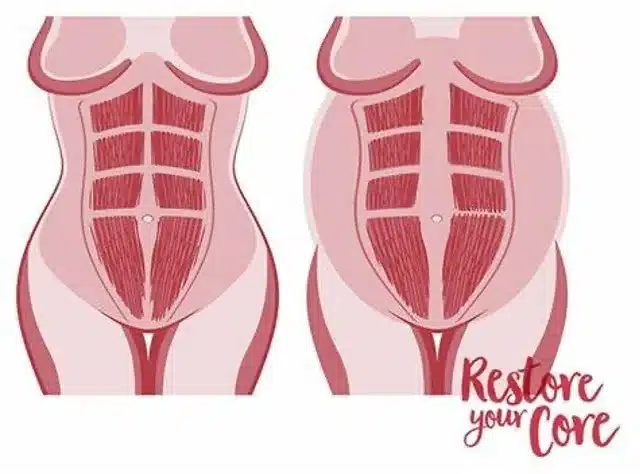Common Problem
One of the most common problems that can result from pregnancy is Diastasis Recti. We will refer to this throughout this reading as “DR.” DR is defined as the separation of the rectus abdominus muscles. You do not have to become pregnant to have DR. This can also be caused by weightlifting incorrectly or performing unsafe abdominal exercises. In those instances, you can prevent DR by bending at your knees to lift instead of your waist. DR affects roughly 60% of pregnant people. It can happen in the 3rd trimester and is especially more likely in pregnancy with multiples. It normally resolves itself within 8 weeks of birth, however, 40% of those with DR still have it by 6 months postpartum.
How to minimize Diastasis Recti
It can be minimized by wearing a belly band that will bring your abdominal muscles together. You should not wear this band for more than 2-3 hours at a time and you should not sleep in the band. Always check with your provider to make sure before wearing the band. A band is a compression garment and may not be a good option for clients with high blood pressure. Belly bands can also help clients who have an unhealed separation from a previous pregnancy. It is also recommended that pregnant clients roll to the side with a pillow between their knees to get out of bed, rather than sitting straight up from a supine position.
Complications
Complications from DR include lower back pain, constipation, urine leakage, painful intercourse, pelvic floor dysfunction, and hernia. Exercise is not contraindicated in pregnancy but working out safely is always recommended! Sometimes trainers recommend crunches, sit-ups, and yoga poses, such as downward dog poses for clients who have previously given birth without knowing they have a DR separation. It is important to be assessed postpartum by your provider so you can take the proper steps to heal your DR and use caution in the gym/at home when lifting other children.
What can be done?
If you have a DR and use a trainer at the gym, make sure they are familiar with DR! In the event you have a major separation, your provider may give you a referral for a surgery consultation. In most cases, being proactive in your postpartum period and wearing an abdominal binder and doing light core exercises will be enough to encourage your muscles back together. Always consult your provider before beginning any new exercise or wearing a support band. A band is a compression garment and may not be a good option for clients with high blood pressure. If you would like to test yourself for DR you can follow these instructions from The Cleveland Clinic. This information is not a replacement for medical care. Call your provider with any questions you have about healing your DR.
How do I test myself for diastasis recti?
You can test yourself for diastasis recti:
- Lie on your back with your knees bent and feet flat on the floor.
- Lift your shoulders slightly off the ground, keeping one hand behind your head for support. Almost like you are doing a sit-up. Look down at your belly.
- Move your other hand above your belly button area, palms down and fingers towards your toes.
- Use your fingers to feel for a gap between the abs. See how many fingers can fit in the gap between your right and left abdominals.
If you feel a gap of two or more finger widths, discuss your concerns with your healthcare provider. They should confirm diastasis recti with a proper diagnosis and recommend appropriate care.

Check out all of the services and other information we have available through Peeping Moms Ultrasound Boutique!
